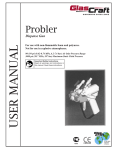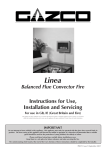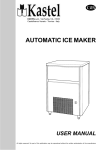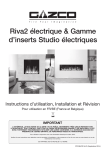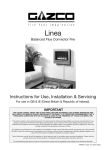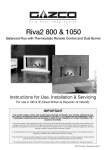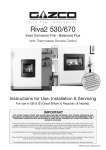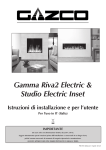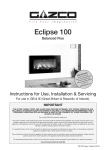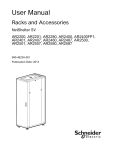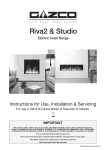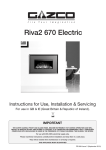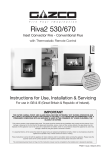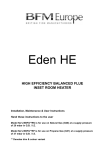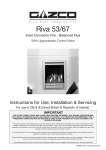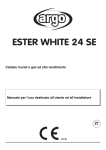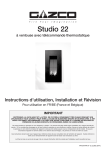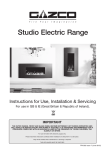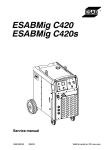Download Riva 2 (PR1070)
Transcript
Riva2 800 & 1050 Balanced Flue Instructions for Use, Installation and Servicing For use in Great Britain and Eire (GB, IE) IMPORTANT This product contains a Heat resistant glass panel. This panel should be checked during Installation and at each servicing interval. If any damage is observed on the front face of the glass panel (scratches, scores, cracks or other surface defects), the glass panel must be replaced and the appliance must not be used until a replacement is installed. Under no circumstances should the appliance be used if any damage is observed, the glass panel is removed or broken. Parts of this appliance will become hot during operation; it is therefore recommended that a suitable guard should be used for protection of young children, the elderly or infirm. This appliance is guaranteed for 2 years (subject to the conditions on page 3 of this Instruction manual). The second year of the guarantee will only be valid if the annual service recommended in this Instruction manual has been completed by a GasSafe registered engineer, and a copy of the service report is available for inspection by a Gazco engineer. These Instructions must be left with the appliance for future reference and for consultation when servicing the appliance. Please make the customer aware of the correct operation of the appliance before leaving these instructions with them. The commissioning sheet found on Page 3 of this Instruction manual must be completed by the Installer prior to leaving the premises. PR1070 Issue 5 (February 2011) COVERING THE FOLLOWING MODELS: Riva2 800: Riva2 1050: 134-031 134-476 134-225 134-568 PAGE Appliance commissioning checklist 3 user instructions 4 instaLlation Instructions 13 Technical Specifications 13 Site Requirements 14 Installation 19 Commissioning 31 Servicing Instructions 32 Fault Finding 32 How to replace parts 34 Basic spare parts list 40 Service Records 41 2 APPLIANCE COMMISSIONING CHECKLIST IMPORTaNT NOTICE Explain the operation of the appliance to the end user, hand the completed instructions to them for safe keeping, as the information will be required when making any guaranteed claims. FLUE CHECK Pass 1. Flue is correct for appliance 2. Flue flow test N/A 3. Spillage test N/A Fail GAS CHECK 1. Gas soundness & let by test 2. Standing pressure test mb 3. Appliance working pressure (on High Setting) mb NB All other gas appliances must be operating on full 4. Gas rate 5. Does ventilation meet appliance requirements N/A m3/h DEALER AND INSTALLER INFORMATION Dealer . . . . . . . . . . . . . . . . . . . . . . . . . . . . . . . . . . . . . . . . . . . . . . . . . . . . . . . . . . . . . . . . . . . . . Installation Company . . . . . . . . . . . . . . . . . . . . . . . . . . . . . . . . . . . . . . . . . . . . . . . . . . . . . . . . . . . . . . . . . . . . . . . . . . . . . . . . . . . . . . . . . . . . . . . . . . . . . . . . . . . . . . . . . . . . . . . . . . . . . . . . ................................................................................ . . . . . . . . . . . . . . . . . . . . . . . . . . . . . . . . . . . . . . . . . . . . . . . . . . . . . . . . . . . . . . . . . . . . . . . . . . . . . . . ................................................................................ Contact No.. . . . . . . . . . . . . . . . . . . . . . . . . . . . . . . . . . . . . . . . . . . . . . . . . . . . . . . . . . . . . . Engineer . . . . . . . . . . . . . . . . . . . . . . . . . . . . . . . . . . . . . . . . . . . . . . . . . . . . . . . . . . . . . . . . . . . Date of Purchase. . . . . . . . . . . . . . . . . . . . . . . . . . . . . . . . . . . . . . . . . . . . . . . . . . . . . . . Contact No.. . . . . . . . . . . . . . . . . . . . . . . . . . . . . . . . . . . . . . . . . . . . . . . . . . . . . . . . . . . . . . . Model No.. . . . . . . . . . . . . . . . . . . . . . . . . . . . . . . . . . . . . . . . . . . . . . . . . . . . . . . . . . . . . . . . Gas Safe Reg No. . . . . . . . . . . . . . . . . . . . . . . . . . . . . . . . . . . . . . . . . . . . . . . . . . . . . . . . Serial No.. . . . . . . . . . . . . . . . . . . . . . . . . . . . . . . . . . . . . . . . . . . . . . . . . . . . . . . . . . . . . . . . . Date of Installation . . . . . . . . . . . . . . . . . . . . . . . . . . . . . . . . . . . . . . . . . . . . . . . . . . . . Gas Type. . . . . . . . . . . . . . . . . . . . . . . . . . . . . . . . . . . . . . . . . . . . . . . . . . . . . . . . . . . . . . . . . . This product is guaranteed for 2 years from the date of installation, as set out in the terms and conditions of sale between Gazco and your local Gazco dealer. This guarantee will be invalid, to the extent permitted by law, if the above Appliance Commissioning Checklist is not fully completed by the installer and available for inspection by a Gazco engineer. The guarantee will only be valid during the second year, to the extent permitted by law, if the annual service recommended in the Instructions for Use has been completed by a Gas Safe registered engineer, and a copy of the service visit report is available for inspection by a Gazco engineer. 3 USER INSTRUCTIONS 1. general In the event of a gas escape or if you can smell gas, please take the following steps: • • • • • • 1.8 Do not use a garden sprinkler or hose near the terminal. 1.9 This product is guaranteed for 2 years from the date of installation, as set out in the terms and conditions of sale between Gazco and your local Gazco dealer. Please consult with your local Gazco dealer if you have any questions. In all correspondence always quote the Model Number and Serial Number. Immediately turn off the gas supply at the meter/ emergency control valve Extinguish all sources of ignition Do not smoke Do not operate any electrical light or power switches (On or Off) Ventilate the building(s) by opening doors and windows Ensure access to the premises can be made IMPORTANT : NEVER position an LCD/Plasma TV above this fire. 2. lighting the appliance Please report the incident immediately to the National Gas Emergency Service Call Centre on 0800 111 999 (England, Scotland and Wales) , 0800 002 001 (N. Ireland) or in the case of LPG, the gas supplier whose details can be found on the bulk storage vessel or cylinder. The gas supply must not be used until remedial action has been taken to correct the defect and the installation has been recommissioned by a competent person. 1.1 Installation and servicing must only be carried out by a competent person whose name appears on the Gas Safe register. To ensure the engineer is registered with Gas Safe they should possess an ID Card carrying the following logo: There are two ways of lighting the appliance: • by thermostatic remote control, see 2A • using the fire’s touch pad, see 2B 2A - THERMOSTATIC and TIMER REMOTE CONTROL 1 Up Down AR2302 1.2 In all correspondence, please quote the appliance type and serial number, which can be found on the data badge located on a plate attached to the lower slotted trim, Diagram 5 Installation Section. 1.3 Do not place curtains above the fire: You must have 300mm (1’) clearance between the fire and any curtains at either side. 1.4 If any cracks appear in the glass panel do not use the appliance until the panel has been replaced. 1.5 In the unlikely event the appliance is receiving interference from other electronic devices, the handset/Control box can be reprogrammed. Please consult your dealer if you think this may be the case. 1.6 If, for any reason, the flue has to be removed from the appliance, the seals must be replaced in the inner spigot. 1.7 Do not obstruct the flue terminal in any way, i.e. by planting flowers, trees shrubs etc in the near vicinity, or by leaning objects up against the terminal guard. 4 Turning the appliance On Your remote can control the gas fire from pilot ignition through to shut down. To turn the fire on: • Press the OFF button and the UP button simultaneously. You hear several short signals. The pilot and main burner ignite and the remote is now in Manual Mode: In ‘MANUAL MODE’ you can: • turn on the main burner using the UP button • regulate the flame from high to low and back • turn off the burner leaving just the pilot burning In ‘TEMP MODE’ (Automatic) you can: • set the room temperature so the thermostat in the remote automatically maintains that temperature In ‘TIMER MODE’ (Automatic) the fire: • turns on and off according to the set time periods • automatically regulates the room temperature during the set periods USER INSTRUCTIONS NOTE: When operating the fire in Temp or Timer mode, the pilot remains lit and the fire then automatically switches on at programmed times to bring the room to the set temperature whether or not you are in the room. NEVER LEAVE ANY COMBUSTIBLE MATERIALS WITHIN 1 METRE OF THE FRONT OF THE APPLIANCE. 2.4 TIMER MODE (AUTOMATIC) There are two programmable settings you can make over a 24 hour period, P1 and P2. These are normally used to provide an early morning and evening setting for each working week: P1 + = Start Timed Setting 1 P1 + = End of Timed Setting 1 P2 + = Start Timed Setting 2 P2 + = End of Timed Setting 2 2.4.1 P1 - Program 1 for a Timed Setting • Press the SET button until the TIMER mode is displayed • Hold the SET button. The displays flashes the current time for P1. While the time displayed is flashing you can alter the hours and minutes set. To set the time your fire first lights, change P1 • Press the UP button to alter the hour • Press the DOWN button to alter the minutes in 10 minute increments • Press SET again to move to the end setting for P1 This is the time your Studio first shuts down: • Press the UP button to alter the hour • Press the DOWN button to alter the minutes 2.4.2 P2 - Program 2 for a Timed Setting Use the same steps outlined in 2.4.1 to change the setting for P2. If you have already set P1 and want to alter the setting for P2 only: • Press the SET button until TIMER mode is displayed • Hold the SET button until the display flashes the current time for P1 • Press the SET button once again to scroll past the settings for P1 and P1 With the time s t i l l flashing: • Press the UP button to alter the hour • Press the DOWN button to alter the minutes Once all four times are set press the OFF button. 2.4.3 To view existing settings: • Select Timer Mode • Press and briefly hold the SET button you see the start time for P1 • Repeat the above step for the start and end of each program. 2.1 SWITCHING BETWEEN MODES • Press the SET button to change to Temperature Mode • Press again to change to Timer Mode • Keep pressing to run through all operating modes. These are: • MAN • DAY TEMP • NIGHT TEMP • TIMER and back to MAN NOTE: MAN mode can also be reached by pressing either the UP or DOWN button 2.2 MAN MODE • Press the OFF button and the UP button simultaneously. You hear several clicks and audible beeps as the fire begins the ignition process , (up to 30 seconds) Turning the appliance Off • Press the OFF button to turn the appliance off FOR SAFETY, YOU MUST WAIT 30 SECONDS BEFORE LIGHTING THE FIRE AGAIN. INCREASE FLAME HEIGHT • Press the UP button once to increase flame height one stage. Press and hold the UP button to increase to maximum. DECREASE FLAME HEIGHT • Press the DOWN button once to decrease flame height one stage. Press and hold the DOWN button to decrease to minimum. At the lowest point the fire goes to 'Standby Mode' (Only Pilot lit). 2.3 NOTE: If you would like the Night temperature control to turn off then decrease the temperature until [--] is displayed. NOTE: While pressing a button a symbol indicating transmission appears on the display. The receiver confirms transmission with a sound signal. TEMP MODE (AUTOMATIC) The display shows the current room temperature. To increase or decrease the fire’s output: • Press the SET button to select either the DAY TEMP or the NIGHT TEMP mode by briefly pressing the SET button • Hold the SET button until the TEMP display flashes and then let go • Set the desired temperature with the UP and DOWN arrows. (Minimum temperature 5C, maximum 40C or 40F to 99F when fahrenheit is the preferred option) • Press the OFF button to stop the display flashing or wait to return to TEMP mode. NOTE: If you set a temperature that is beneath the current room temperature, the fire automatically switches to PILOT (Stand by). 2.5 LOW BATTERY “BATT” is displayed on the remote when its batteries need replacement. 2.6 5 SETTING THE TIME • Simultaneously press the up and down buttons • Press the up button to set the hour and the down button to set the minutes • Press OFF to return to the manual mode or simply wait USER INSTRUCTIONS 2.7 SETTING THE °C/24 HOUR OR °F/12 HOUR CLOCK • Press OFF and the down arrow until the display changes from °C/24 hour clock to °F/12 hour clock and vice versa. If the remote is removed, lost or damaged, signals transmitted to the receiver cease. Your fire will go to standby (pilot) mode after 6 hours. 3. CLEANING the RIVA2 2B - TOUCH PAD CONTROL 2 3.1 Make sure the fire and surrounds are cool before cleaning. Use a damp cloth to clean the painted frame and use soap and water for the glass. Clean the burner using a vacuum cleaner with a soft brush attachment. Ensure all debris is removed from the burner ports. In the unlikely event soot is deposited on the logs, use a soft brush to remove. 3.2 To remove the glass door: Remove the side trims, Diagram 4 4 AR1885 The UP button to increase the flame height. Press the DOWN button to decrease the flame height. At the lowest point it goes to ‘standby mode’, (only pilot lit). Press the ON-OFF button again to turn the appliance off 2C EMERGENCY SHUT OFF If the batteries fail during use of the fire, move the switch to the OFF (O) position, Diagram 3 (This switch is set to be ON during normal operation and must remain ON) AR2280 To operate the switch insert a thin screwdriver through the semi circular cut out in the lower slotted trim. The switch is located on the right hand side of the appliance under the slotted trim. These are held on by magnets. 3.3 Lift out the bottom slotted trim, Diagram 5 5 TAKE EXTREME CARE AS THE GLASS WILL BE VERY HOT 3 AR2279 AR2273 3.4 6 Remove all the screws around the door. (10 on the 800 model and 9 on the 1050 model) Please note: The screws are located down both sides and along the bottom edge of the glass frame. USER INSTRUCTIONS 3.5 Lift the door using the handle, up and over the lower edge Take extreme care not to damage the paint, Diagram 6 8 6 AR2305 PLEASE ENSURE NO WIRES ARE TRAPPED BEFORE REPLACING THE WALL PLATE. THE TOUCH PAD LEAD IS EASILY DAMAGED 5. ARRANGEMENT OF FUEL BED AR2275 3.6 Lower the door - the top edge will be hooked onto the top of the appliance. 3.7 Hold the sides of the door and lift approximately 25mm and pull the top forward. This will release the door - Lower to clear the appliance 3.8 Refit in reverse order. When refitting the door ensure the top is hooked over the lip on the firebox, Diagram 6. ADVICE ON HANDLING AND DISPOSAL OF FIRE CERAMICS 4. CHANGING THE appliance BATTERIES The appliance batteries are located behind the wall switch plate. 4.1 Undo the two screws securing the wall switch and plate and remove, Diagram 7 The fuel effect in this appliance is made from Refractory Ceramic Fibre (RCF), a material which is commonly used for this application. 7 AR2304 4.2 Unclip the battery holder from the wall switch and remove the old batteries. 4.3 Correctly position the four new AA size batteries into the battery holder. Re-assemble the battery holder as shown in Diagram 8 When servicing the appliance it is recommended that the replaced items are not broken up, but are sealed within heavy duty polythene bags and labelled as RCF waste. RCF waste is classed as stable, non-reactive hazardous waste and may be disposed of at a licensed landfill site. Excessive exposure to these materials may cause temporary irritation to eyes, skin and respiratory tract; wash hands thoroughly after handling the material. 5.1 Vermiculite for Logs Layout Use the entire bag of supplied Vermiculite. TAKE CARE NOT TO SPILL VERMICULITE INTO THE PILOT AREA. ONLY VERMICULITE SUPPLIED BY GAZCO SHOULD BE USED IN THIS FIRE. 5.2 Log Layout LOGS MUST BE POSITIONED ACCORDING TO THE FOLLOWING INSTRUCTIONS TO GIVE THE CORRECT FLAME EFFECT 5.3 Use all the vermiculite to fill the burner tray and spread evenly across the whole burner The centre ramp does not have vermiculite on it. 7 Protective clothing is not required when handling these articles, but we recommend you follow normal hygiene rules of not smoking, eating or drinking in the work area and always wash your hands before eating or drinking. To ensure that the release of RCF fibres are kept to a minimum, during installation and servicing a HEPA filtered vacuum is recommended to remove any dust accumulated in and around the appliance before and after working on it. USER INSTRUCTIONS The logs are identified with letters A - H on the underside or rear of the log. A, B, C, D and G have holes to locate the logs on the pins fixed to the burner skin, Diagram 9. There are two bags of effect material. One consists of black embers, the other is a special pack of Embaglow. This looks like wire wool and is placed after the logs are arranged. Logs E and F have interlocking recesses which locate with logs B and D. H has no locations but will rest in a specific position. 5.4 Locate Log A on the pin in front of the pilot. Ensure the left hand side of the log rest on the upper part of the burner, Diagram 9 9 G B A A D 5.5 C Locate Log B on the top left hand pin. The end of the log nearest the front of the appliance will rest on the side liner on the 800 model. On the 1050 model a distance of 25-30mm between the front left corner of the burner and the log is required, Diagram 10 10 B A 5.6 Locate Log C on the lower burner right hand pin. The rear of the log should touch the black air guide between the upper and lower burners, Diagram 11 11 C B A 8 USER INSTRUCTIONS 5.7 Locate Log D on the lower left hand pin. The hole is in the short branch of the log. The left hand side of the log sits in the groove on Log B, Diagram 12 12 B C D A 5.8 Place Log E on top of Log D. Engage the raised location into the recess on Log E. The rear of the log pushes against the right side of the raised tag on the rear of the burner, see Diagram 13 13 B E C D A 5.9 Place Log F on top of Log B and engage the raised locator into the recess on Log F. The right end of the log pushes against the raised tag on the rear of the burner, Diagram 14 14 F B E C D A 9 USER INSTRUCTIONS 5.10 Place Log G on the two remaining pins. The charred effect faces forward, Diagram 15 15 F B G E C D A 5.11 Log H locates on three points. The short branch locates in the recess on the Left Hand side of Log G. The main body of Log H rests on Log E and the front charred area of Log H rests between Log A and C on the raised tag, Diagram 16 16 H F G B C D A 5.12 The black embers are now placed underneath the logs C and D on the lower burner only. A few embers are placed between Logs D and A. Place the remaining embers between logs A and C. For best effect ensure no black embers are forward of the log front faces, Diagram 17 17 H F G B C D A 10 USER INSTRUCTIONS 5.13 Lastly locate the Embaglow wire wool. Take care when positioning to ensure the best final effect. Note: ONLY half the material supplied is used Separate half the material by hand and place the remainder back in the bag - the customer must keep this for use in the future. The material must be pulled into shape until only a very thin layer is applied onto the burner - too much material being used can diminish the flame effect. The size of each piece is approximate. Loose strands of material can be trimmed with a pair of scissors. This will make it easier to apply. There are six areas the Embaglow is placed in. Ensure it does not overhang the front of the burner, Diagram 18 and 19 18 100 70 70 30 30 100 30 100 80 30 30 30 AR2247 19 AR2247 NOTE: This material will last approximately 500 hours burning. It is a consumable part and should be replaced when necessary. It can be purchased from your local dealer, Part No. GZ8471. 9. servicing 7. flame failure device 7.1 9.1 This is a safety feature incorporated on this appliance which automatically switches off the gas supply if the pilot goes out and fails to heat the thermocouple. 8. running in 8.1 The surface coating on the materials used in your GAZCO fire will "burn off" during the first few hours of use producing a harmless and temporary odour. This will disappear after a short period of use. If the odour persists, ask your installer for advice. The fire must be serviced every 12 months by a qualified Gas Engineer. In all correspondence always quote the Model number and the Serial number which may be found on the data badge which is attached to the lower slotted trim. 10. ventilation 10.1 Any purpose provided ventilation should be checked periodically to ensure that it is free from obstruction. 11 USER INSTRUCTIONS 11. installation details 11.1 Your installer should have completed the commissioning sheet at the front of this book. This records the essential installation details of the appliance. In all correspondence always quote the Model number and Serial number. 12. HOT SURFACES 12.1 Parts of this appliance become hot during normal use. • Regard all parts of the appliance as a ‘working surface’ • Provide a suitable fire guard to protect young children and the infirm 13. FIRE WILL NOT LIGHT 13.1 If you cannot light the Riva2: • Check that the emergency shut off switch is in the ON (1) position, see Section 2C, Emergency Shut Off • Check and change the batteries in the remote handset • Check and change the appliance batteries, Section 4 • Consult your Gazco dealer if the Riva2 still does not light 12 INSTALLATION INSTRUCTIONS TECHNICAL SPECIFICATION COVERING THE FOLLOWING MODELS: Model Gas CAT. Gas Type riva2 800 riva2 1050 134-031 134-225 134-476 134-568 Working Pressure Aeration Injector Gas Rate m3/h Input kW (Gross) High Low Country Riva2 800 BF I2H Natural (G20) 20mbar 12mm Ø 600 0.835 9.0 4.5 GB, IE Riva2 800 BF I3P Propane (G31) 37mbar 14.5mm Ø (x2) 150 0.316 8.4 4.2 GB, IE Riva2 1050 BF I2H Natural (G20) 20mbar 12mm Ø 600 0.835 9.0 4.5 GB, IE Riva2 1050 BF I3P Propane (G31) 37 mbar 14.5mm Ø (x2) 150 0.316 8.4 4.2 GB, IE Efficiency Class 2 - 82% / NOx Class 5 Flue Outlet Size Ø 150mm Flue Inlet Size Ø 100mm Gas Inlet Connection Size Ø 8mm RESTRICTOR REQUIREMENT VERTICAL & HORIZONTAL FLUE TOP EXIT - VERTICAL ONLY INCLUDING OFFSET RIVA2 800 BF RIVA2 BF 800 and 1050 Vertical Flue Height Horizontal Length Restrictor Size Vertical Flue Height Restrictor Size 200mm - 500mm Up to 500mm No restrictor 3000 - 4990mm 60mm Ø 500mm - 1000mm Up to 1000mm No restrictor 5000mm - 10,000mm 52mm Ø 1000mm - 1490mm Up to 1000mm No restrictor 1500mm - 1990mm Up to 5000mm No restrictor 2000mm - 3000mm Up to 5000mm 75mm Ø RIVA2 1050 BF Vertical Flue Height Horizontal Length Restrictor Size 200mm - 500mm Up to 500mm No restrictor 500mm - 1000mm Up to 1000mm No restrictor 1000mm - 1490mm Up to 1000mm No restrictor 1500mm - 1990mm Up to 5000mm No restrictor 2000mm - 3000mm Up to 5000mm 75mm Ø 13 INSTALLATION INSTRUCTIONS TECHNICAL SPECIFICATION This appliance has been certified for use in countries other than those stated. To install this appliance in these countries, it is essential to obtain the translated instructions and in some cases the appliance will require modification. Contact Gazco for further information. PACKING CHECKLIST Qty Description Fixing Kit containing:- 1 Log Set including Ember Pack 1 Vermiculite Pack 1 Chimney Renovation Kit Front Cover (Left Hand) 1 Chimney Renovation Kit Front Cover (Right Hand) 2 Chimney Renovation Kit Rear Cover 8 Fixing Screws (for Chimney Renovation Kit Cover Plates) 1 1 4 1 1 2 1 1 1 x x x x x x x x x Instruction Manual Handset AA cell batteries 9V cell batteries wall box wall plate screws touch pad/wall plate battery holder Embaglow pack AR2242 AR2243 14 INSTALLATION INSTRUCTIONS SITE REQUIREMENTS 1.5 Two types of flue terminals are available, horizontal and vertical. To measure for a horizontal terminal: • Decide on the terminal position • Measure the height from the top of the appliance to the centre of the required outlet. For minimum and maximum flue dimensions see Diagram 2 and 3. • Allow enough room either above or to the side of the appliance to assemble the flue on top • Assemble a horizontal flue in the following order: - Vertical section - 90° elbow - Horizontal plus terminal 1. Flue and Chimney Requirements Note: This appliance must only be installed with the flue supplied. You must adhere to the following: 1.1 The flue must be sited in accordance with BS5440: Part 1 (latest edition). See Diagram 1. 1.2 Fit a guard to protect people from any terminal less than 2 metres above any access such as level ground, a balcony or above a flat roof. 1.3 All vertical and horizontal flues must be securely fixed and fire precautions followed in accordance with local and national codes of practice. 1.4 A restrictor may be required. Refer to Technical Specifications on page 12. 1 UK Dimensions 15 • Support the opening of a masonry installation with a lintel. 1.6 Only the horizontal terminal section can be reduced in size. INSTALLATION INSTRUCTIONS SITE REQUIREMENTS RIVA2 1050 - Kit No. 8523 2. FLUE OPTIONS RIVA2 800 BF Vertical from the top of the appliance then horizontally out. (See Diagram 3). The basic kit comprises: 1 x 500mm vertical length 1 x 500mm terminal length (cut to length on site) 1 x 90° elbow 1 x wall plate 1 x 75mm restrictor 2 The kit may be used on its own. (Note – RIVA2 800 with a 200mm rise only the 500mm terminal length can be used). Extra lengths may be added to the vertical and horizontal from the list below, See Section 2.5 2.2 TOP FLUE UP & OUT WITH ADDITIONAL BEND Any additional bend may be used on the horizontal section (either 45° or 90°), but the overall horizontal flue run will be reduced. Refer to Diagram 4. AR1671 4 RIVA2 1050 BF 3 AR2246 Riva2 800 & 1050 When A = 1.0 to 1.499 metres B + C = 1.0 metres maximum When A = 1.499 metres to 3.0 metres B + C = 4.0 metres maximum Start of bend to centre line of horizontal flue 170mm. Centre line of vertical flue to end of bend 220mm. 2.1 TOP FLUE UP & OUT KIT AR1672 RIVA 2 800 - Kit No. 8534 2.3 TOP FLUE VERTICAL KIT (8524/8524AN) Vertical from the top of the appliance then horizontally out. (See Diagram 2). The basic kit comprises: 1 x 200mm vertical length 1 x 500mm terminal length (cut to length on site) 1 x 90° elbow 1 x wall plate 1 x 75mm restrictor 1 x 70mm restrictor - Not used on this appliance 1 x 60mm restrictor - Not used on this appliance 16 Vertical from the top of the appliance (See Diagram 5). A minimum vertical rise 3m (9’10") to a maximum 10m (32’10"). The basic kit comprises: 2 x 1m lengths 1 x 1m terminal length 1 x 52mm restrictor 1 x 47mm restrictor - Not used on this appliance 1 x 60mm restrictor 1 x 70mm restrictor - Not used on this appliance Extra lengths may be added from the list below. INSTALLATION INSTRUCTIONS SITE REQUIREMENTS 5 3. GAS SUPPLY AR1673 This appliance is intended for use on a gas installation with a governed meter. 3.1 Before installation, ensure that the local distribution conditions (identification of the type of gas and pressure) and the adjustment of the appliance are compatible. 3.2 Ensure the gas supply delivers the required amount of gas and is in accordance with the rules in force. 3.3 You can use soft copper tubing on the installation and soft soldered joints outside the appliance and below the fire. 3.4 A factory fitted isolation device is part of the inlet connection; no further isolation device is required. 3.5 All supply gas pipes must be purged of any debris that may have entered prior to connection to the appliance. 3.6 The gas supply enters through the aperture located on the RIGHT-HAND side of the box. 2.4 TOP FLUE VERTICAL OFFSET KIT (8530/8530AN) 4. VENTILATION Used with kit 8524. A minimum rise of 500mm (191/2) is required to the first bend. See Diagram 5. 4.1 2.5 EXTRA FLUE LENGTHS 5. APPLIANCE LOCATION All flue components are 150mm diameter (6") NOMINAL LENGTH Actual LENGTH Stainless finish Anthracite finish 200mm 140mm 8527 8527AN 500mm 440mm 8528 8528AN 1000mm 940mm 8529 8529AN 40° Bend N/A 8507 8507AN 90° Bend N/A 8508 8508AN RIVA 2 BALANCED FLUE INSTALLATION FOR STUDWORK/FALSE CHIMNEY BREAST. 5.1 While the figures quoted in these instructions for clearances to combustible materials etc conform to the relevant standards; it is advisable to read the following notes. 5.2 Due to the high efficiency and high temperatures expected from a Glass Fronted Appliance it is advisable to plan carefully the exact method of installation. It is generally considered that the temperatures are higher on a balanced flue version due to the extra efficiency. NOTE: Carefully consider: a) Terminal positions b) Flue supports c) Weatherproofing d) Fire precautions 5.3 For all the above options, you must conform to local and national codes of practice. 2.6 CHIMNEY RENOVATION KIT (999-668) This appliance requires no additional ventilation. 5.4 Details of the Chimney Renovation Kit are available in the separate Installation Instructions - PR1181 Chimney Renovation Kit Instructions. 17 The studwork can be formed using metal or wood framework paying particular attention to the diagram showing combustible material distances. The carcass must consist in part of totally fire proof materials such as Supalux, Masterboard or Monolux. The fireproof board names as shown above are factory names and so there will be others available. (Contact your local building supplier) It is strongly recommended that a single sheet of this material also surrounds the fascia of the appliance to the sides and to the top to provide maximum heat proofing. Plasterboard can be used on the outer limits of your false chimney breast/studwork and then it should be possible to PVA the construction using a neat solution and a plaster finish. INSTALLATION INSTRUCTIONS SITE REQUIREMENTS 5.5 There are also Plaster products on the market which can be used in areas of higher temperatures that have successfully been used in some installations. (Vitcas and Envirograf are two examples) It may be prudent to contact the suppliers or manufacturers of these products to check your particular application or requirements. 5.6 Please remember that the expansion and contraction properties will be different between fireproof boarding and plasterboard and so a joint, or introduction of the two materials too close to the appliance may result in plaster cracking. 5.7 To avoid an unnecessary build up of heat in the void created, fit 2 vents at high level. The high level vents could be fitted at such a height that following engineers on a service could in fact inspect any flue work in the void. The enclosure must also be constructed to leave a gap between the top of the wall and the ceiling. IMPORTANT : NEVER position an LCD/Plasma TV above this fire. 5.10 5.11 This appliance must stand on a non-combustible platform that is at least 12mm thick. 5.12 Although a hearth is not required, consideration for the young, elderly and infirm should be given. This is to prevent accidental touching of the glass as it reaches high temperature. 5.8 Please note this appliance has been primarily designed for studwork applications. However, there are circumstances where the appliance could be installed in a block or brickwork fireplace using different methods and materials for the final effect. This void must be vented, See Diagram 4, Section 2. 5.9 This appliance is not suitable for installation onto a combustible wall. Remove all combustible material from the area shown. See Diagram 6 6 150 100 AR2250 A combustible shelf must be: • maximum 150mm in depth • minimum, 150mm high above the fire A combustible side wall must be a minimum of 150mm from the appliance. NOTE: If you intend to construct the fascia of the fireplace opening from natural materials it is recommended you cut this into three or more sections to prevent cracking. Resin-based materials may not be suitable. This appliance is an effective heat producer and attention must be paid to the construction and finish of the fireplace. 18 INSTALLATION INSTRUCTIONS INSTALLATION IMPORTANT NOTE: DUE TO THE DESIGN OF THE APPLIANCE NO CONVECTED AIR IS EMITTED FROM THE FRONT. WHEN INSTALLED IN THE FALSE CHIMNEY BREAST ALL THE HOT AIR IN THE VOID IS RETURNED INTO THE ROOM THROUGH EITHER THE TWO VENTS OR THE GAP LEFT AT THE TOP OF THE WALL. 1 Skimmed Finish IMPORTANT: REFER TO DATA BADGE AND TECHNICAL SPECIFICATION AT THE FRONT OF THE MANUAL TO ENSURE THE APPLIANCE IS CORRECTLY ADJUSTED FOR THE GAS TYPE AND CATEGORY APPLICABLE IN THE COUNTRY OF USE. FOR DETAILS OF CHANGING BETWEEN GAS TYPES REFER TO SECTION 14, SERVICING, ‘REPLACING PARTS’. Wall Finish 1. SAFETY PRECAUTIONS 1.1 For your own and other’s safety, you must install this appliance according to local and national codes of practice. Failure to install the appliance correctly could lead to prosecution. Read these instructions before installing and using this appliance. 1.2 These instructions must be left intact with the user. 1.3 Do not attempt to burn rubbish on this appliance. 1.4 Keep all plastic bags away from young children. 1.5 Do not place any object on or near to the appliance and allow adequate clearance above the appliance. IF THE APPLIANCE IS EXTINGUISHED OR GOES OUT IN USE, WAIT 3 MINUTES BEFORE ATTEMPTING TO RELIGHT THE APPLIANCE. AR2254 IF IT IS INTENDED TO FIT THIS APPLIANCE WITH A GAZCO STONE FIREPLACE, MANTEL OR HEARTH & SLIP SET, IT WILL BE NECESSARY TO REFER TO THE INSTRUCTIONS SUPPLIED WITH THE SURROUND OR MANTEL TO ENSURE THE RIVA2 IS INSTALLED AT THE CORRECT HEIGHT, See Diagram 1A 1A 2. INSTALLATION METHODS THE appliance can be installed into a false chimney breast. This is constructed of wood or metal studwork with a plasterboard and skimmed finish. A brick and block construction with plasterboard and skimmed finished can also be used. AR2201 The final appearance of the installation falls into one of the following categories: 1) A plastered and painted wall 2) A stone fireplace 3) A tiled or marble finish For installation 3 if the tile or marble is to finish flush with the black frame then the wall finish will have to be a set distance behind the frame depending on the tile/marble thickness, see diagram 2 a fixing kit is available for this installation: 800 KIT NO: 999-440 1050 KIT NO: 999-321 The appliance has a purpose built frame to ensure the wall finish is always in the correct position. For installations 1 and 2 the wall finish sits against the flanges on the sides and the vertical faces top and bottom of the black frame, see diagram 1 19 Attach the upper bar by screwing through the top of the black frame using the screw provided. This forms a vertical face to support the tile/marble finish, Diagram 2. The lower bar is attached under the bottom of the black frame. The screws are inserted INSTALLATION INSTRUCTIONS INSTALLATION downwards behind the frame, Diagram 2. Due to the expansion of metal it is advisable not to use adhesive between the tile/marble and the support bars. Only use adhesive between the tile/marble and the wall finish. 3 2 Fixing screw Tile/Marble Upper Bar AR2248 2.2 DO NOT PACK THE VOID AROUND OR ABOVE THE APPLIANCE WITH INSULATION MATERIALS SUCH AS MINERAL WOOL. 2.3 THE VOID BUILT FOR THE CASSETTE MUST BE VENTILATED TO PREVENT A BUILD-UP OF HEAT. YOU MUST FIT 2 VENTS OF APPROXIMATELY 100CM2 EACH. THESE VENTS RETURN WARM AIR BACK INTO THE ROOM, SEE DIAGRAM 4 Tile/Marble 4 Lower Bar Fixing screw AR2253 Alternatively the tile/marble can overhang forward of the black frame but must not protrude inside so as to reduce the size of the door frame aperture. 2.1 DISTANCE TO COMBUSTIBLE MATERIAL COMBUSTIBLE PARTS OF THE STUDWORK MUST BE KEPT BEYOND THE MINIMUM DIMENSIONS SHOWN IN DIAGRAM 3. EVEN IF THE FRAMEWORK IS PROTECTED BY NON-COMBUSTIBLE MATERIAL, YOU MUST MAINTAIN THESE DIMENSIONS, DIAGRAM 3. 75mm AR2249 20 2.4 alternatively the enclosure can be constructed to leave a gap between the top of the wall and the ceiling. ensure the open area is equal to or greater than the two vents. 2.5 AN ACCESS HATCH MUST BE LEFT IN THE SIDE OF THE CHIMNEY BREAST FOR FUTURE SERVICING AND INSPECTION OF THE FLUE AND APPLIANCE. INSTALLATION INSTRUCTIONS INSTALLATION 3.5 3. installation of the appliance 3.1 Remove the appliance from the carton and discard all unnecessary packaging. Ensure no components are thrown away when unpacking 3.2 If the appliance is being fitted with a Gazco Chimney Renovation Kit, the four supplied metal cover plates MUST be fitted to the appliance heat shield - see PR1181 Chimney Renovation Kit instructions, Section 4 Page 8. If the Chimney Renovation Kit is NOT being used then the cover plates can be discarded. THE COVER PLATES MUST NOT BE FITTED TO THE APPLIANCE IF IT IS BEING INSTALLED WITH A STANDARD GAZCO FLUE OPTION AS LISTED IN THIS INSTALLATION BOOKLET (Page 16 Section 2). 3.3 Remove all the screws around the door. (10 on the 800 model and 9 on the 1050 model) Please note: The screws are located down both sides and along the bottom edge of the glass frame. 3.6 Lift the door using the handle, up and over the lower edge Take extreme care not to damage the paint, Diagram 7 7 To remove the glass door: Remove the side trims, Diagram 5 5 AR2275 These are held on by magnets. 3.4 Lift out the bottom slotted trim, Diagram 6 Lower the door - the top edge will be hooked onto the top of the appliance. 3.8 Hold the sides of the door and lift approximately 25mm and pull the top forward. This will release the door - Lower to clear the appliance 3.9 Remove the box from the appliance and store safely as it contains the remote control and fuel effects, etc. 3.10 Remove all the vermiculite liners. The rear panels can remain in place. See Replacing Parts, Section 4. AR2280 3.7 3.11 Remove the Main Burner, see Replacing Parts, Section 5. 3.12 The gas supply enters the fire through the RIGHT HAND side of the appliance along with the battery and touch pad leads, Diagram 8 6 8 Gas Inlet AR2264 AR2279 21 INSTALLATION INSTRUCTIONS INSTALLATION 3.17 The 8mm compression fitting can now be attached to the flexible pipe. The pipe may be bent to suit the fitters pipework. Riva 2 gas inlet pipe The Riva 2 is supplied with a flexible pipe extension to aid installation from the appliance inlet to the rigid gas supply pipe. 4. STUDWORK INSTALLATION FOR RIVA 2 3.13. To fit the Gas Inlet extension: Gain access to the isolating elbow NOTE: if the appliance is to be raised off the floor ensure the platform is suitably supported. these appliances are very heavy. 4.1 Build the studwork chimney breast and enclosures to the desired size to include the protected platform at the required height. 4.2 Line the aperture for the appliance with 12mm thick non- combustible material as shown, Diagram 13 and 14. 3.14 Remove the isolating elbow from the inlet pipe 3.15 Bend the flexible pipe as shown, Diagram 10. 10 13 AR2363 3.16 Fix the isolating elbow on the flexible pipe and secure using an 8mm Pipe Nut. 11 Isolating Elbow 8mm Pipe Nut AR2255 Flexi-pipe 14 AR2364 3.17. Thread the flexible pipe through the top of the control cover and out of the access hole in the side of the appliance. Attach the isolating elbow back onto the inlet pipe, See page 21 for details on the Isolating Elbow. 150 12 AR2256 Flexi-pipe AR2365 22 INSTALLATION INSTRUCTIONS INSTALLATION • Do Not fit a timber bottom on the floor in front of the appliance as this will block the airflow Use the metal bracket provided, Diagram 9. 5. wall box & battery installation • Ensure the clearances are maintained, Diagram 11 • Site the appliance and decide on flue requirements • Cut a hole for the flue exit - see Installation Instructions, Flue Assembly • Provide gas into the cassette void on the right-hand side NOTE: The touch pad and battery lead are long enough to allow the touch pad and battery box to be sited on the left hand side of the appliance. 4.3 Fit non-combustible board to the studwork around the fire. This should extend a minimum of 150mm above the appliance and at least 100mm to the sides of the appliance, Diagram 15. It is however recommended that this is extended further to prevent cracking. When installing the wall box allow at least 100mm of slack wire in the touch pad lead and battery lead where they enter the appliance on the right hand side. This allows the removal of the control assembly during servicing 5.1 Decide on the position for the wall box containing the batteries and wall switch and cut the necessary hole. Connect the wire from the fire to the battery pack, Diagram 17. 17 15 AR1920 5.2 150 Connect the wire from the fire to the touch pad/connector, Diagram 18. 18 100 AR2250 4.4 Apply plasterboard to the remainder of the studwork. Apply a plaster finish to the front of the chimney breast. 4.5 To finish this installation connect the wall box and batteries following instruction in Section 5 below/ Connect: - the flue system (see Installation, Flue Assembly) - and gas services (see Installation 2.3) using the opening in the side of the chimney breast for access. AR2306 5.3 Correctly position the four new AA size batteries and re-assemble the battery holder as shown, Diagram 19. 19 After commissioning finish the sides of the chimney breast, Diagram 16. 12 AR2305 5.4 AR1905 23 Secure the wall switch plate to the wall box using the two fixing screws, Diagram 20. INSTALLATION INSTRUCTIONS INSTALLATION 20 Drill small holes around the circumference when using method b. Make good both ends of the hole. 6.6 Allow enough room either above or to the side of the appliance to assemble the flue on top. Assemble a horizontal flue in the following order: - Vertical section - 90° elbow - Horizontal plus terminal Support the opening of a masonry installation with a lintel. 6.7 Only the horizontal terminal section can be reduced in size. wall plate AR2304 5.5 Important The wall switch must be installed using a nonmetallic mounting box, please ensure that the plastic dry lining box is used wherever possible. If it is intended to install the wall switch on a masonry it is possible to drill through the rear of this box and secure in position using wall plugs and screws although a small amount of finishing work will be required to cover the plastic side securing tags. Alternatively a standard 47mm deep pattress box can be used to surface mount the wall switch. To find the length measure from the outside of the wall to the stop on the 90° Add 10mm to the outlet end Measure from the edge of the slots closest to the wall and mark around the flue, Diagram 21. 21 6. FLUE ASSEMBLY 10mm 6.1 Refer to Flue Options in Site Requirements on page 15. TAKE CARE WHEN MARKING OUT FOR THE FLUE AS IT IS DIFFICULT TO MOVE AFTER INSTALLATION. IF A RESTRICTOR IS REQUIRED FIT THIS BETWEEN THE SMALL OUTLET SPIGOT AND THE AIR DUCT SEE DIAGRAM 17. REFER TO TECHNICAL SPECIFICATIONS FOR RESTRICTOR SIZE. AR0629 21 A wall plate is supplied to fix the flue to the wall: Bend the tab to 90° Assemble the plate onto the flue but wait to secure to wall and flue after the flue is fully assembled. 6.8 The cardboard fitment in the terminal is used to support the flue whilst it is cut to length. ONCE CUT TO SIZE, REMOVE THE CARDBOARD REMNANT, Diagram 22. 22 AR0627 6.2 A 152mm (6") diameter hole in the wall is required to install the flue. This can be achieved by either: a) Core drill b) Hammer and chisel AR0630 24 INSTALLATION INSTRUCTIONS INSTALLATION TOP EXIT - VERTICAL FLUE If a vertical only flue system has been purchased refer to Site Requirements, Diagram 8. The following areas need careful consideration: a) Terminal Positions b) Flue Supports c) Weatherproofing d) Fire Precautions For all of the above, local and national codes of practice must be adhered to. 7.1 VERMICULITE PANELS NOTE: RIVA2 FRONT AND REAR PANELS ARE IN TWO PIECES. The rear panels are already in place. Ensure the two-piece rear panels are centralised, with the chamfers touching and pushed together, Diagram 23. 23 TABLE A - TOP EXIT - VERTICAL ONLY, INCLUDING OFFSET Vertical Height from Floor Restrictor Size 3,000mm to 4,990mm 60mm Ø 5,000mm to 10,000mm 52mm Ø Flue temp 400˚C 6.9 7. ASSEMBLING THE APPLIANCE AR2263 Connect a suitable pressure gauge to the test point located on the inlet fitting • Replace the burner NOTE: On the Riva2 1050 the burner can be permanently fixed. The Riva2 800 burner has to be removed after the pressure check. This is to allow access to refit the controls cover plate. 7.2 Place the left hand and right hand L shaped lower panels either side of the burner, Diagram 24. 24 6.10 Turn on the gas and light the appliance. Check for leaks. 6.11 Turn the appliance to maximum and check that the supply pressure is as stated on the data badge. 6.12 Turn off the gas and replace the test point screw 6.13 Turn the gas back on and check the test point for leaks AR2263 7.3 Place the left and right hand front strips on the front edge of the firebox. The rear of the vermiculite strips are angled to match the angled stops on the firebox. Centralise the strips and ensure all the chamfers align, Diagram 25. 25 AR2266 25 INSTALLATION INSTRUCTIONS INSTALLATION 7.4 Place the side panels on top of the lower panels and secure with clips. The side panels are not handed. Ensure the grooves align with the rear panels, Diagram 26. 26 AR2257 8. ARRANGEMENT OF FUEL BED When servicing the appliance it is recommended that the replaced items are not broken up, but are sealed within heavy duty polythene bags and labelled as RCF waste. RCF waste is classed as stable, non-reactive hazardous waste and may be disposed of at a licensed landfill site. Excessive exposure to these materials may cause temporary irritation to eyes, skin and respiratory tract; wash hands thoroughly after handling the material. 8.1 Vermiculite for Logs Layout Use the entire bag of supplied Vermiculite. TAKE CARE NOT TO SPILL VERMICULITE INTO THE PILOT AREA. ONLY VERMICULITE SUPPLIED BY GAZCO CAN BE USED IN THIS FIRE. 8.2 Log Layout LOGS MUST BE POSITIONED ACCORDING TO THE FOLLOWING INSTRUCTIONS TO GIVE THE CORRECT FLAME EFFECT 8.3 Use all the vermiculite to fill the burner tray and spread evenly across the whole burner The centre ramp does not have vermiculite on it. ADVICE ON HANDLING AND DISPOSAL OF FIRE CERAMICS The fuel effect in this appliance is made from Refractory Ceramic Fibre (RCF), a material which is commonly used for this application. The logs are identified with letters A - H on the underside or rear of the log. A, B, C, D and G have holes to locate the logs on the pins fixed to the burner skin, Diagram 24. Protective clothing is not required when handling these articles, but we recommend you follow normal hygiene rules of not smoking, eating or drinking in the work area and always wash your hands before eating or drinking. To ensure that the release of RCF fibres are kept to a minimum, during installation and servicing a HEPA filtered vacuum is recommended to remove any dust accumulated in and around the appliance before and after working on it. Logs E and F have interlocking recesses which locate with logs B and D. H has no locations but will rest in a specific position. There are two bags of effect material. One consists of black embers, the other is a special pack of Embaglow. This looks like wire wool and is placed after the logs are arranged. 8.4 Locate Log A on the pin in front of the pilot. Ensure the left hand side of the log rest on the upper part of the burner, Diagram 27. 27 G B A D 8.5 A C Locate Log B on the top left hand pin. The end of the log nearest the front of the appliance will rest on the side liner on the 800 model. On the 1050 model a distance of 25-30mm between the front left corner of the burner and the log is required, Diagram 28. 26 INSTALLATION INSTRUCTIONS INSTALLATION 28 B A 8.6 Locate Log C on the lower burner right hand pin. The rear of the log should touch the black air guide between the upper and lower burners, Diagram 29. 29 C B A 8.7 Locate Log D on the lower left hand pin. The hole is in the short branch of the log. The left hand side of the log sits in the groove on Log B, Diagram 30. 30 B C D A 8.8 Place Log E on top of Log D. Engage the raised location into the recess on Log E. The rear of the log pushes against the right side of the raised tag on the rear of the burner, see Diagram 31. 27 INSTALLATION INSTRUCTIONS INSTALLATION 31 B E C D A 8.9 Place Log F on top of Log B and engage the raised locator into the recess on Log F. The right end of the log pushes against the raised tag on the rear of the burner, Diagram 32. 32 F B E C D A 8.10 Place Log G on the two remaining pins. The charred effect faces forward, Diagram 33. 33 F B G E C D A 28 INSTALLATION INSTRUCTIONS INSTALLATION 8.11 Log H locates on three points. The short branch locates in the recess on the Left Hand side of Log G. The main body of Log H rests on Log E and the front charred area of Log H rests between Log A and C on the raised tag, Diagram 34. 34 H F G B C D A 8.12 The black embers are now placed underneath the logs C and D on the lower burner only. A few embers are placed between Logs D and A. Place the remaining embers between logs A and C. For best effect ensure no black embers are forward of the log front faces, Diagram 35. 35 H F G B C D A 8.13 Lastly locate the Embaglow wire wool. Take care when positioning to ensure the best final effect. Note: ONLY half the material supplied is used Separate half the material by hand and place the remainder back in the bag - the customer must keep this for use in the future. The material must be pulled into shape until only a very thin layer is applied onto the burner - too much material being used can diminish the flame effect. The size of each piece is approximate. Loose strands of material can be trimmed with a pair of scissors. This will make it easier to apply. There are six areas the Embaglow is placed in. Ensure it does not overhang the front of the burner, Diagram 36 and 37. 29 INSTALLATION INSTRUCTIONS INSTALLATION 36 100 70 70 30 30 30 100 100 80 30 30 30 AR2247 37 AR2247 NOTE: This material will last approximately 500 hours burning. It is a consumable part and should be replaced when necessary. It can be purchased from your local dealer, Part No. GZ8471. 10.2 Using the handle in the bottom of the frame lift the frame over the bottom trim and locate onto the lower brackets. Keep pressure on the top of the frame to ensure it hooks back onto the firebox. 10. COMPLETION OF ASSEMBLY 10.1 To fit the window frame: NOTE: IT IS ADVISABLE TO PROTECT THE LOWER BLACK TRIM AS THIS IS EASILY SCRATCHED 10.3 Align all the holes and locate all the screws. DO NOT TIGHTEN. Starting with the bottom screws and working upwards tighten all the screws in the frame. DO NOT OVERTIGHTEN THE SCREWS. Insert the top of the window frame behind the black trim and hook the frame onto the vertical face of the firebox, Diagram 38. Carefully rest the bottom of the frame up against the appliance 10.4 Place the slotted trim over the studs to cover the gap at the bottom of the window. The louvres point forwards, Diagram 39 38 39 AR2279 AR2274 30 INSTALLATION INSTRUCTIONS INSTALLATION/COMMISSIONING 10.5 Place the magnetic side trims against the sides of the black frame, Diagram 40. TOUCH PAD CONTROL 39 40 AR1885 AR2280 11. LIGHTING THE STUDIO Note: The Emergency Shut Off switch must be in the ON position, refer to Section 2, User Instructions. There are two ways of lighting the Studio: • by thermostatic remote control • using the fire’s touch pad • Press the ON-OFF button to light the appliance, (up to 30 seconds) • Press the UP button to increase the flame height. • Press the DOWN button to decrease the flame height. At the lowest point it goes to ‘standby mode’, (only pilot lit) • Press the ON-OFF button to turn the appliance off. 1. COMMISSIONING 1.1 THERMOSTATIC REMOTE CONTROL 38 1.2 Complete the Commissioning Checklist at the front of this manual covering: • Flue checks • Gas checks • Log layout - flame picture For working pressure test, use the access panel at the gas connection ensuring the burner is in position. In the unlikely event that the appliance is receiving interference from other electronic devices, re-programme the handset/Control box Reprogramming handset/Control box AR2304 This remote controls the appliance from pilot ignition through to shut down. In ‘MANUAL MODE’ you can: • light the pilot • turn on the main burner • regulate the flame from low to high and back • turn off the burner leaving just the pilot burning In ‘TEMP MODE’ you can: • set the room temperature so the stove automatically maintains that temperature In ‘TIMER MODE’ the fire: • turns on and off according to the set time periods • automatically regulates the room temperature during the set periods 31 To access the control box see Servicing Instructions, Section 6 - Main Control Assembly. • Press and hold the reset button on the control box until you hear two signals. After the second longer signal: • Release the reset button and within 20 seconds • Press the DOWN button on the handset until you hear an additional long signal confirming the new code SERVICING INSTRUCTIONS SERVICING / FAULT FINDING CHARTS 1. SERVICING REQUIREMENTS 2. Fault Finding IMPORTANT – The glass panel on this appliance should be checked for any signs of damage on the front face of the glass panel (scratches, scores, cracks or other surface defects). If damage is observed, the glass panel must be replaced and the appliance must not be used until a replacement is installed. Under no circumstances should the appliance be used if any damage is observed. Please isolate the appliance until a replacement glass panel has been obtained and installed. Replacement glass panels can be purchased from Gazco via the dealer from which the appliance was purchased or any other Gazco distributor. This appliance must be serviced at least once a year by a competent person. All tests must be carried out in accordance with the current Gas Safe recommendations. 1.1 Before any tests are undertaken on the appliance: • Conduct a gas soundness test for the property to ensure there are no gas leaks prior to starting work 1.2 • Fully check the operation of the appliance Special checks 1.2.1 Clean any lint or fluff from the pilot - pay particular attention to the aeration holes of the pilot 1.2.2 Clean away any fluff or lint from under the burner 1.2.3 Check the spark gap on the pilot is correct • Correct any faults found during the initial tests • Recommission the appliance conducting the usual safety checks 1.3 Advise the customer of any remedial action taken. REPLACE BATTERIES BEFORE ATTEMPTING TO RECTIFY ANY FAULTS. IF THE FIRE DOES NOT WORK, BUT HAS WORKED IN THE PAST: • CHECK THE EMERGENCY SHUT OFF SWITCH IN THE BOTTOM RIGHT CORNER BY THE DOOR IS SWITCHED ON, SEE USER SECTION, PAGE 6 Electronic Control Valve Fault Analysis Cause Remedy 3 Short beeps from control Batteries low in appliance Replace appliance batteries No ignition, 5 second continuous tone (there may be several short beeps before) 1. On/Off switch is in OFF position 2. Loose/damaged wire 1. Move switch to ON position 2 Check interrupter block and wires No ignition, no tone, motor turns slightly when operated Receiver board damaged Replace receiver No pilot flame and control continues to spark Thermocouple circuit wired incorrectly Correct wiring Pilot lights, control continues to spark, value shuts down after 10 - 30 seconds 1. No spark at pilot burner 2. Loose/damaged wire 1. Rectify spark at pilot burner 2. Check interrupter and wires 32 SYSTEM OK GO TO THE NEXT CHART IGNITION FUNCTIONAL CHECK 2 No There is a blockage in the system, check the inlet test point, the mag seating and valve. Check thermocouple leads for correct orientation, condition and connection Has the system got any air in it? Yes Purge the gas pipes and retry. Yes Yes Is the gas pressure correct? No Correct and retry. Check isolation tap and gas meter, retry. No Is the gas turned on to the appliance? No Will the pilot light with a match? Yes Check alignment of pilot burner head, change the ignition lead. See Replacing Parts, section 2. Yes Is the control being operated correctly? No Consult User Instructions and retry. No Does the pilot light? Yes Operate the valve. Is there a spark? No Ensure there is no debris around the pilot assembly, (e.g. soot, etc.) which could short the spark, clean the area. PILOT WILL NOT LIGHT IGNITION FUNCTIONAL CHECK 1 Yes Symptom 33 Replace the lead, retry. No Has the ignition lead become detached from the control box? No Replace the electrode Yes Correct and retry. Check the tab on the pilot burner is not damaged. Either repair tab or replace pilot burner and retry. Is the valve being operated correctly? Check handset batteries are OK. Replace if required. Check handset is on manual. Check if handset lock is off. Check batteries to the control unit. Replace if required. Retry with handset and touch pad. Check that the on/off switch is in On position, diagram 13 Users Instructions. Replace the ignition lead and retry. Yes Yes No No Remove the ignition lead from electrode. With insulated pliers. Hold the tip 4.0mm from the pilot pipe work, is there a spark when the system is operated? No Has ignition lead become detached or is connection poor? Yes Is the gap between electrode and thermocouple 4.0mm? Yes From Ignition Fault Finding Chart 1 Consult the users instructions, retry. Ensure there is no debris around the pilot assembly, (e.g. soot etc.) which could short the spark, clean the area. NO SPARK IGNITION FUNCTIONAL CHECK 2 Yes Change the pilot unit. No Is the pilot flame of the correct length? Is the thermocouple in its correct position in the pilot bracket. See Replacing Parts, section 8.5 Yes With the pilot running is the gas pressure as stated on the data badge? Yes No Will pilot stay alight? SYSTEM OK Change mag unit. No Will pilot stay alight? No No No Yes Yes Replace pilot unit. No Is thermocouple connection good in back of valve? Problem is with the pipe work or fittings which lead to the fire. Correct and retry. Yes No Yes Run for 3 mins, turn off, time interval until mag unit shuts with a click. Is this greater than 7 seconds? Tighten the connection and retry. Run for 3 mins, turn off, time interval until mag unit shuts with a click. Is this greater than 7 seconds? Yes With the fire running on full is the gas at the pressure stated on the data badge? Light the pilot using either the handset or the touch pad Ensure there is no debris around the pilot assembly, (e.g. soot etc.) Check for fluff in the pilot aeration hole. See the Diagram in the Replacing Parts section. PILOT WILL NOT STAY LIT OR FIRE GOES OUT IN USE No Yes Is the flue working? Yes Rectify flue FLAME FAILURE FUNCTIONAL CHECK 3 SERVICING INSTRUCTIONS FAULT FINDING CHARTS SERVICING INSTRUCTIONS REPLACING PARTS 3.4 1. GENERAL 1.1 All main components can be replaced without removing the appliance from its installation. It is essential that the gas supply to the appliance is turned off at the isolation device before proceeding further. 1.2 3.5 Lift the door using the handle, up and over the lower edge Take extreme care not to damage the paint, Diagram 3 3 DISCONNECT BATTERIES BEFORE SERVICING THE APPLIANCE 1.3 Remove all the screws around the door. (10 on the 800 model and 9 on the 1050 model) Please note: The screws are located down both sides and along the bottom edge of the glass frame. Removal of Flue If, for any reason, the flue has to be removed from the appliance, the seal must be replaced in the inner spigot. 1.4 Access to the controls is restricted and the whole of the control assembly is to be removed as one unit. Refer to Section 8 below 2. WINDOW FRAME ASSEMBLY 3.2 To remove the glass door: Remove the side trims, Diagram 1 AR2275 1 3.6 Lower the door - the top edge will be hooked onto the top of the appliance. 3.7 Hold the sides of the door and lift approximately 25mm and pull the top forward. This will release the door - Lower to clear the appliance 3.8 Refit in reverse order. When refitting the door ensure the top is hooked over the lip on the firebox, Diagram 3. 3. GLASS WINDOW 3.1 AR2280 These are held on by magnets. 3.3 Lift out the bottom slotted trim, Diagram 2 Remove the two screws and clips from the underside of the glass frame. Lift the bottom of the glass out and drop down to release it from the bottom of the frame, Diagram 4 4 2 AR2267 AR2279 34 SERVICING INSTRUCTIONS REPLACING PARTS 4. VERMICULITE PANELS 7 NOTE: RIVA2 FRONT AND REAR PANELS ARE IN TWO PIECES: 4.1 A VERMICULITE PANELS To remove the vermiculite panels it will be necessary to remove the logs and burner see Section 5. Release the screws at the top of the side panels and rotate the brackets. Lean the top of the panel inwards and remove. Repeat with the other side, Diagram 5 4.2 B 5 4.6 AR2270 To remove the right hand liner slide it to the left hand side and repeat the above procedure, Diagram 8 8 AR2257 4.3 Remove the left and right hand front strips of vermiculite, along with the left and right hand L shaped panels. 4.5 AR2272 To remove the rear panels loosen the retaining bracket at the top of the liners, Diagram 6 6 AR2261 Lift the left hand liner off the lower support and lower it between the rear air guide (arrow A) and burner fixing bracket (arrow B). Lean the top forward and remove the liner, Diagram 7 35 4.7 To replace the liners reverse the above procedure, noting the following points. a) Replace the rear right hand liner first by lowering the bottom of the liner between the rear air guide and burner fixing bracket. Then lift and insert the top behind the top baffle but in front of the back support top rail. Locate the bottom on the lower support rail and slide fully to the right hand side of the appliance with the chamber running centrally. Repeat with the left hand liner Ensure the two-piece rear panels are centralised, with the chamfers touching and pushed together. b) When replacing the L shaped panels and the front strips, ensure the chamfers align where the liners touch, Diagram 9 SERVICING INSTRUCTIONS REPLACING PARTS 8 9 AR2264 6.3 Isolate the gas supply at the isolation device and disconnect the gas inlet, Diagram 9 AR2266 9 5. maIN BURNER 5.1 To replace the main burner: • Remove the Logs, Embaglow, Black Embers and the vermiculite Take care when removing the Embaglow. AR2268 Remove the vermiculite liners except for the two rear panels. 6.4 Remove the seven screws from the top of the control cover and a further four screws at the rear, Diagram 10 Remove the two burner fixing screws from the left side of the burner, Diagram 10 10 10 AR2265 5.4 Move the burner to the left to clear the injector. There is a stop to prevent the burner from breaking the electrode Lift the burner vertically taking care not to hit the pilot electrode Refit in reverse order AR2269 6.5 11 6. maIN CONTROL ASSEMBLY 6.1 To access the main control assembly, first remove: • Window frame • Vermiculite panels • Main burner 6.2 To remove the access panel: • Undo the two screws, Diagram 8 Remove the two screws securing the air guide at the rear of the control compartment, Diagram 11 AR2260 36 SERVICING INSTRUCTIONS REPLACING PARTS 6.6 Release the On/Off switch from it's bracket situated on the right hand side between the front of the firebox and the black trim, Diagram 12 The pilot burner bracket can now be removed. • Replace in reverse order Ensure the black vidaflex cover is pushed up to the back of the pilot bracket covering the thermocouple and ignition lead. 7.3 Electrode Pull the ignition lead off the electrode and undo the retaining nut, Diagram 14 12 14 AR2273 6.7 Before the assembly can be completely removed, the battery and touch pad lead must be disconnected from the right hand side of the control box, Diagram 13 13 AR1349 AR2258 6.8 Feed the switch wire through the aperture in the front of the firebox. The control assembly can now be removed Replace with a new electrode. Do not over-tighten the nut; this could break the component • Replace the ignition lead 7.4 Pilot Injector Undo the pilot pipe from the control cover and from the underside of the pilot burner and remove the pipe. The injector drops out from the burner, Diagram 15. Replace in reverse order. When replacing the screws, locate the two screws on the top rear corners first. All the top screws are M5x10 machine screws. The rear four screws are all self tapping screws. 15 7. PILOT UNIT ASSEMBLY 7.1 The pilot assembly consists of four components which can be individually changed: 1. Pilot burner bracket 2. Pilot injector 3. Electrode 4. Thermocouple Before commencing work on the pilot the Main Burner must be removed, see Section 7 above. 7.2 Pilot Burner Bracket • • • • Remove Remove Remove Remove the the the the AR2264 electrode, see paragraph 9.3 thermocouple, see paragraph 9.5 pilot pipe two screws securing the bracket 37 7.5 Thermocouple To remove the thermocouple the control assembly will have to be removed, See Section 6 Disconnect the thermocouple from the gas valve/interrupter, Diagram 17, Arrow B. Undo the thermocouple nut in the back of the pilot bracket half a turn. This releases the thermocouple. SERVICING INSTRUCTIONS REPLACING PARTS Remove the screw and sealing plate from the rear of the cover. Then remove the Black vidaflex cover from the thermocouple and re-use it on the new component When replacing with a new thermocouple, take care to bend the new component to the same shape as the thermocouple just removed. 9. GAS VALVE 9.1 To change the gas valve: First remove the control assembly, see Section 6, then release the gas inlet pipe, Diagram 17, Arrow A To refit the thermocouple into the pilot bracket, ensure it is pushed fully into the hole. There is a stop on the thermocouple to set the height. 9.2 The remove the thermocouple from the interrupter block and release the two thermo current cables 9.3 Release the pilot pipe, Diagram 17, B and release the injector feed pipe, Diagram 17, C. Lock the retaining nut just enough to grip the thermocouple and connect the thermocouple to the valve/ interrupter and take care not to over-tighten. 9.4 Remove the wire cable by inserting a small flat screwdriver in the top of the white plug, Diagram 18. Fit a new cable tie to the vidaflex inside the control cover 9.5 Remove the two screws, Diagram 17, D. The valve can now be freed. Refit the cover plate and seal with a suitable silicone sealant D 17 8. IGNITION LEAD A 16 B C AR2271 18 AR2262 8.1 To replace the ignition lead remove the Main Control Assembly, see Section 6. Carefully remove the ignition lead from the electrode. 8.2 Undo the screw and sealing plate from the rear of the control cover and pull the black control box forward. This is held on by velcro pads. 8.3 Release the cables from the clip on the underside of the assembly. This allows the control box to be pulled forward. 8.4 Feed the ignition lead through the aperture in the rear of the control cover, Diagram 16. Pull the control box to expose the ignition lead. AR2278 10. MAGNETIC SAFETY VALVE Remove the main control assembly, See Section 6. 10.1 To replace the magnetic safety valve: Note the direction of the lead. The new lead must follow exactly the same route. NOTE: THE IGNITION LEAD MUST NOT PASS IN FRONT OF THE CONTROL BOX AS THIS CAN DAMAGE THE SENSITIVE ELECTRONICS. Undo the thermocouple from the interrupter block and remove the two thermo current cables. Then unscrew the interrupter block from the back of the valve. 10.2 Undo the silver magnetic valve retaining nut on the back of the valve and gently tap out the mag valve. When replacing the lead re-use the black vidaflex. Ensure it is pushed up to the rear of the electrode. Use a new cable tie on the inside of the control cover. Reseal the cover plate with a suitable silicone sealant. 10.3 Replace with a new unit and reassemble in reverse order 38 SERVICING INSTRUCTIONS REPLACING PARTS 12. main injector 11. CONTROL BOX 11.1 To replace the control box first remove the main control assembly, See Section 6. 12.1 To change the main injector undo the injector fee pipe and remove the lock nut from the injector. 11.2 Release the cables from the clip on the underside of the assembly. Then remove the sealing plate from the rear of the control box. 12.2 Replace with the correct size injector. 13. Primary Aeration Plate 11.3 Pull the control box forward and remove the ignition lead followed by the two thermo current cables by removing the two screws. NOT ALL MODELS HAVE AERATION PLATES. REFER TO NOTE AT BEGINNING OF INSTALLATION INSTRUCTIONS. 13.1 Remove the burner module as described in Servicing section 5. 11.4 Remove the eight wire loom from the control box. When replacing the sealing plate on the rear of the control cover use a suitable silicone sealant. 18 Thermo current cables 13.2 Remove the fixing screw and remove the plate off the venturi. Eight wire cable 13.3 Replace with the correct size plate and secure with the screw. 19 Ignition lead Touch pad extension cable AR0619 14. Changing between Gas Types Battery extension cable In order to change between gas types, it will be necessary to change the following items: Burner Assembly - NG: GZ8234N - LPG: GZ8234P Control Assembly: AR1915 11.5 After replacing the control box you may need to reprogram the handset Press and hold the reset button on the control box until you hear two signals. After the second longer signal: • Release the reset button and within 20 seconds • Press the DOWN button on the handset until you hear an additional long signal confirming the new code 39 NG LPG 800 GZ8212N GZ8212P 1050 GZ8231N GZ8231P Data Badge - PR0393 RIV 2 A kit of parts is available for this, always quote the Model number and Serial number when ordering any spare parts. NOTE: THE CONTROL VALVE IS FACTORY PRESET FOR THE CORRECT GAS TYPE AND MODEL, A NEW UNIT WILL NEED TO BE ORDERED WHEN CHANGING BETWEEN GAS TYPES. SERVICING INSTRUCTIONS REPLACING PARTS 18. ShoRt Spares List riva 2 - 850 COMPONENT riva 2 1050 NG LPG NG LPG PILOT INJECTOR PI0069 PI0070 PI0069 PI0070 MAIN INJECTOR IN0032 IN0058 IN0032 IN0058 GZ8234N GZ8234P GZ8234N GZ8234P G20 - ME1350 12mm Ø G31 - N/A G20 - ME1350 12mm Ø G31 - N/A BURNER ASSEMBLY AERATION PLATE ELECTRODE PI0075 PI0075 THERMOCOUPLE PI0074 PI0074 MAG UNIT GC0092 GC0092 IGNITION LEAD GC0125 GC0125 GAS VALVE GC0123 GC0123 CONTROL BOX GC0150 GC0150 REMOTE CONTROL GC0149 GC0149 INTERRUPTOR BLOCK GC0124 GC0124 THERMOCURRENT CABLE GC0136 GC0136 THERMOCURRENT SWITCH CABLE GC0128 GC0128 TOUCH PAD GC0164 GC0164 TOUCH PAD LEAD GC0144 GC0144 BATTERY HOLDER EL0410 EL0410 BATTERY HOLDER CABLE GC0138 GC0138 CONTROL BOX/VALVE CABLE GC0133 GC0133 Vermiculite back panel CEO780 CEO773 Vermiculite side panel CEO783 CEO778 Vermiculite BASE panel (LH) CEO781 CEO776 Vermiculite BASE panel (RH) CE0782 CE0832 Vermiculite Front panel (LH) CEO774 CEO833 Vermiculite front panel (RH) CEO796 CEO834 EMBAGLOW GZ8471 GZ8471 VERMICULITE (LOOSE) CEO746 CEO746 LOG SET CEO777 CEO777 GLASS PANEL GZ8487 GZ8488 40 SERVICE RECORDS 1ST SERVICE 2ND SERVICE Date of Service:........................................................................... Date of Service:........................................................................... Next Service Due:....................................................................... Next Service Due:....................................................................... Signed:........................................................................................ Signed:........................................................................................ Dealer's Stamp/Gas Safe Registration Number Dealer's Stamp/Gas Safe Registration Number 3RD SERVICE 4TH SERVICE Date of Service:........................................................................... Date of Service:........................................................................... Next Service Due:....................................................................... . Next Service Due:....................................................................... Signed:........................................................................................ Dealer's Stamp/Gas Safe Registration Number Signed:........................................................................................ Dealer's Stamp/Gas Safe Registration Number 6TH SERVICE 5TH SERVICE Date of Service:........................................................................... Date of Service:........................................................................... Next Service Due:....................................................................... Next Service Due:....................................................................... Signed:........................................................................................ Signed:........................................................................................ Dealer's Stamp/Gas Safe Registration Number Dealer's Stamp/Gas Safe Registration Number 8TH SERVICE 7TH SERVICE Date of Service:........................................................................... Date of Service:........................................................................... Next Due:........................................................................ Next Service Due:....................................................................... Signed:........................................................................................ Signed:........................................................................................ Dealer's Stamp/Gas Safe Registration Number Dealer's Stamp/Gas Safe Registration Number 10TH SERVICE 9TH SERVICE Date of Service:........................................................................... Date of Service:........................................................................... Next Service Due:....................................................................... Next Service Due:....................................................................... Signed:........................................................................................ Signed:........................................................................................ Dealer's Stamp/Gas Safe Registration Number Dealer's Stamp/Gas Safe Registration Number 41 Gazco Limited, Osprey Road, Sowton Industrial Estate, Exeter, Devon, England EX2 7JG Technical Customer Services (01392) 261950 Fax: (01392) 261951 E-mail: [email protected] A member of the Stovax Group











































